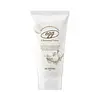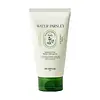What's inside
What's inside
 Key Ingredients
Key Ingredients

 Benefits
Benefits

 Concerns
Concerns

 Ingredients Side-by-side
Ingredients Side-by-side

Water
Skin ConditioningMyristic Acid
CleansingGlycerin
HumectantPotassium Hydroxide
BufferingPalmitic Acid
EmollientStearic Acid
CleansingLauric Acid
CleansingSucrose
HumectantCocamidopropyl Betaine
CleansingOlea Europaea Fruit Oil
MaskingCetearyl Olivate
Polyglyceryl-10 Laurate
Skin ConditioningParfum
MaskingEgg Yolk Extract
EmulsifyingAlbumen Extract
EmollientSorbitan Olivate
EmulsifyingSodium Chloride
MaskingSolanum Lycopersicum Fruit Extract
AntioxidantGlycyrrhiza Glabra Root Extract
BleachingDaucus Carota Sativa Root Extract
Skin ConditioningCentella Asiatica Extract
CleansingCamellia Sinensis Leaf Extract
AntimicrobialDisodium EDTA
Butylene Glycol
HumectantDipotassium Glycyrrhizate
HumectantSalicylic Acid
MaskingArgania Spinosa Kernel Oil
EmollientPolysorbate 80
EmulsifyingPhenoxyethanol
PreservativeOleth-7
EmulsifyingSesamum Indicum Seed Oil
EmollientBeta-Sitosterol
Emulsion StabilisingSerenoa Serrulata Fruit Extract
Skin ConditioningSulfur
AntiseborrhoeicTocopherol
AntioxidantGlycine Soja Seed Extract
Skin ConditioningChamomilla Recutita Flower Extract
MaskingButylphenyl Methylpropional
PerfumingLinalool
PerfumingHydroxycitronellal
PerfumingWater, Myristic Acid, Glycerin, Potassium Hydroxide, Palmitic Acid, Stearic Acid, Lauric Acid, Sucrose, Cocamidopropyl Betaine, Olea Europaea Fruit Oil, Cetearyl Olivate, Polyglyceryl-10 Laurate, Parfum, Egg Yolk Extract, Albumen Extract, Sorbitan Olivate, Sodium Chloride, Solanum Lycopersicum Fruit Extract, Glycyrrhiza Glabra Root Extract, Daucus Carota Sativa Root Extract, Centella Asiatica Extract, Camellia Sinensis Leaf Extract, Disodium EDTA, Butylene Glycol, Dipotassium Glycyrrhizate, Salicylic Acid, Argania Spinosa Kernel Oil, Polysorbate 80, Phenoxyethanol, Oleth-7, Sesamum Indicum Seed Oil, Beta-Sitosterol, Serenoa Serrulata Fruit Extract, Sulfur, Tocopherol, Glycine Soja Seed Extract, Chamomilla Recutita Flower Extract, Butylphenyl Methylpropional, Linalool, Hydroxycitronellal
Oenanthe Javanica Extract 15%
AntimicrobialWater
Skin ConditioningGlycerin
HumectantMethylpropanediol
SolventPalmitic Acid
EmollientStearic Acid
CleansingMyristic Acid
CleansingPotassium Hydroxide
BufferingLauric Acid
CleansingPotassium Cocoyl Glycinate
Salicylic Acid
MaskingCoco-Glucoside
CleansingGlyceryl Stearates
EmollientCentella Asiatica Extract
CleansingFicus Carica Fruit Extract
HumectantCarthamus Tinctorius Flower Extract
Skin ConditioningGardenia Florida Fruit Extract
Skin ConditioningHamamelis Virginiana Bark/Leaf/Twig Extract
Skin ConditioningSalix Alba Bark Extract
AstringentPogostemon Cablin Leaf Oil
MaskingJuniperus Virginiana Oil
MaskingArtemisia Vulgaris Oil
PerfumingMentha Arvensis Leaf Oil
MaskingHydrogenated Lecithin
EmulsifyingBetaine
HumectantSorbitan Olivate
EmulsifyingPolyquaternium-22
Beta-Glucan
Skin ConditioningAllantoin
Skin ConditioningGluconolactone
Skin ConditioningSodium Phytate
Capryloyl Salicylic Acid
ExfoliatingPanthenol
Skin ConditioningCeramide NP
Skin ConditioningNiacinamide
SmoothingLinolenic Acid
CleansingBiotin
AntiseborrhoeicCyanocobalamin
Skin ConditioningAscorbic Acid
AntioxidantTocopheryl Acetate
AntioxidantPantothenic Acid
Skin Conditioning1,2-Hexanediol
Skin ConditioningOenanthe Javanica Extract 15%, Water, Glycerin, Methylpropanediol, Palmitic Acid, Stearic Acid, Myristic Acid, Potassium Hydroxide, Lauric Acid, Potassium Cocoyl Glycinate, Salicylic Acid, Coco-Glucoside, Glyceryl Stearates, Centella Asiatica Extract, Ficus Carica Fruit Extract, Carthamus Tinctorius Flower Extract, Gardenia Florida Fruit Extract, Hamamelis Virginiana Bark/Leaf/Twig Extract, Salix Alba Bark Extract, Pogostemon Cablin Leaf Oil, Juniperus Virginiana Oil, Artemisia Vulgaris Oil, Mentha Arvensis Leaf Oil, Hydrogenated Lecithin, Betaine, Sorbitan Olivate, Polyquaternium-22, Beta-Glucan, Allantoin, Gluconolactone, Sodium Phytate, Capryloyl Salicylic Acid, Panthenol, Ceramide NP, Niacinamide, Linolenic Acid, Biotin, Cyanocobalamin, Ascorbic Acid, Tocopheryl Acetate, Pantothenic Acid, 1,2-Hexanediol
Ingredients Explained
These ingredients are found in both products.
Ingredients higher up in an ingredient list are typically present in a larger amount.
Centella Asiatica Extract (Centella) is derived from an herb native to Southeast Asia. It is famous for its anti-inflammatory and soothing properties.
Centella is rich in antioxidants and amino acids, such as Madecassic Acid and Asiaticoside.
Studies show the compounds in centella help with:
The combination of all these properties makes centella effective at soothing, hydrating, and protecting the skin.
Other great components of centella include Vitamin A, vitamin C, several B vitamins, and Asiatic Acid.
Fun fact: Centella has been used as a medicine and in food for many centuries. As a medicine, it is used to treat burns, scratches, and wounds.
Learn more about Centella Asiatica ExtractGlycerin is already naturally found in your skin. It helps moisturize and protect your skin.
A study from 2016 found glycerin to be more effective as a humectant than AHAs and hyaluronic acid.
As a humectant, it helps the skin stay hydrated by pulling moisture to your skin. The low molecular weight of glycerin allows it to pull moisture into the deeper layers of your skin.
Hydrated skin improves your skin barrier; Your skin barrier helps protect against irritants and bacteria.
Glycerin has also been found to have antimicrobial and antiviral properties. Due to these properties, glycerin is often used in wound and burn treatments.
In cosmetics, glycerin is usually derived from plants such as soybean or palm. However, it can also be sourced from animals, such as tallow or animal fat.
This ingredient is organic, colorless, odorless, and non-toxic.
Glycerin is the name for this ingredient in American English. British English uses Glycerol/Glycerine.
Learn more about GlycerinLauric Acid is a fatty acid or lipid. About half of fatty acids in coconut oil is lauric acid.
This ingredient helps hydrate and sooth skin. As a humectant, it helps trap moisture. It also aids in cleaning and enhancing the texture of products.
Lauric acid may not be Malassezia folliculitis, or fungal acne, safe.
Learn more about Lauric AcidMyristic Acid is a saturated fatty acid. It is naturally found in milk fat. Other sources include palm oil, coconut oil, and butter fat.
Myristic Acid is an emulsifer and cleanser. As an emulsifer, it stabilizes a product by preventing ingredients from separating. Myristic Acid helps clean your skin by acting as a surfactant. It tends to gather oil and dirt on your skin to be easily rinsed away.
One study from 2021 found Myristic Acid to have anti-inflammatory properties.
Learn more about Myristic AcidPalmitic Acid is a fatty acid naturally found in our skin and in many plant and animal sources. In cosmetics, it is usually derived from palm oil. It serves many purposes in skincare, acting as a cleanser, emollient, and emulsifier.
As an emollient, palmitic acid helps soften and smooth the skin by preventing water loss. In cleansers, it helps remove oil and dirt while creating foam.
Its emulsifying properties help stabilize products by keeping water and oil-based ingredients from separating.
This may not be suitable for fungal acne-prone skin, as fatty acids like this can sometimes trigger breakouts in sensitive individuals.
Learn more about Palmitic AcidPotassium hydroxide is commonly known as caustic potash. It is used to fix the pH of a product or as a cleaning agent in soap. In cleansers, it is used for the saponification of oils.
Sapnification is the process of creating fatty acid metal salts from triglycerides and a strong base. During this process, Potassium Hydroxide is used up and is not present in the final product.
Using high concentrations of Potassium Hydroxide have shown to irritate the skin.
Learn more about Potassium HydroxideSalicylic Acid (also known as beta hydroxy acid or BHA) is a well-known ingredient for treating skin that struggles with acne and clogged pores. It exfoliates both the skin's surface and deep within the pores to help clear out buildup, control oil, and reduce inflammation.
Unlike AHAs (alpha hydroxy acids), salicylic acid is oil-soluble. This allows it to penetrate into pores which makes it especially effective for treating blackheads and preventing future breakouts.
Salicylic acid is also known for its soothing properties. It has a similar structure to aspirin and can calm inflamed or irritated skin, making it a good option for acne-prone skin that is also sensitive.
Concentrations of 0.5-2% are recognized by the U.S. FDA as an over-the-counter topical acne product.
It can cause irritation and/or dryness if one's skin already has a compromised moisture barrier, so it's best to focus on repairing that before introducing this ingredient into your routine.
While salicylic acid does not increase sun sensitivity, it’s still important to wear sunscreen daily to protect your skin.
If you are looking for the ingredient called BHA or Butylated Hydroxyanisole, click here.
Learn more about Salicylic AcidSorbitan Olivate is created from the fatty acids in olive oil and sorbitol.
This ingredient is an oil in water emulsifier. It helps stabilize a product by preventing oils and waters from separating. Sorbitan Olivate also helps hydrate the skin.
Manufacturers sell sorbitan olivate under the name OliveM 1000. OliveM 1000 a multifunctional ingredient. It is self-emulsifying. According to a manufacturer, OliveM 1000 does not disrupt natural skin biome.
Due to its olive oil base, this ingredient may not be fungal-acne safe.
Learn more about Sorbitan OlivateStearic Acid is a fatty acid. It is an emollient, emulsifier, and texture enhancer.
As an emollient, stearic acid helps soften skin. It aids the skin's protective barrier by preventing water loss. It also provides a gentle cleansing effect without stripping away natural oils.
Stearic acid may also be used to enhance the texture of products. It can add volume and stabilize ingredients such as water and oil. This can help water and oil ingredients from separating.
Sources of stearic acid include animal or vegetable fats/oils such as coconut or shea. It can be naturally found in butter, cocoa butter, shea butter, vegetable fats, and animal tallow.
This ingredient may not be Malassezia folliculitis, or fungal-acne safe.
Learn more about Stearic AcidWater. It's the most common cosmetic ingredient of all. You'll usually see it at the top of ingredient lists, meaning that it makes up the largest part of the product.
So why is it so popular? Water most often acts as a solvent - this means that it helps dissolve other ingredients into the formulation.
You'll also recognize water as that liquid we all need to stay alive. If you see this, drink a glass of water. Stay hydrated!
Learn more about Water